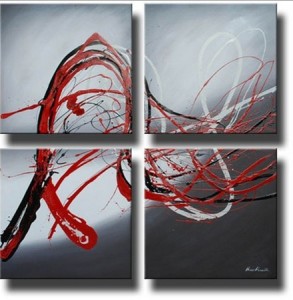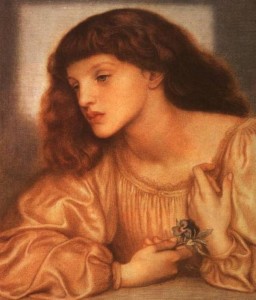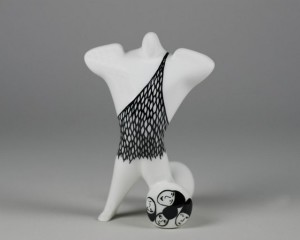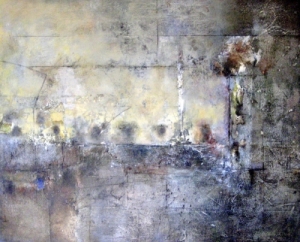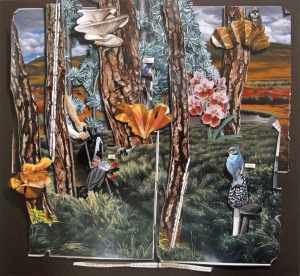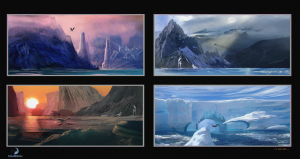This is an edited transcript of a two hour conversation with invited participants which took place on 20 October 1989 at Fulham Palace.
Artists: Kate Davis (K.D.), Bethan Huws (B. H.), Liliane Lijn (L.L.), Jacqui Poncelet (J.P.), Alison Wilding (A.W.), Questioners: Caryn Faure Walker (Editor WASL Journal) (C. F.W.), Rebecca Fortnum (Painter, Writer) (R. F.), Desa Philippi (Art historian) (D.P.).
Transcription Rebecca Fortnum.
C.F.W. Although various exhibitions have presented your work together, there is no record of a discussion between you. Is this silence effective?
A.W. You are talking about silence as a kind of protection. Clearly it’s not helpful to hide behind that protection. But on the other hand I think it’s quite valid to want that silence and not to make statements about what you do.
J.P. I’d agree. Things get constantly analysed and put forward which might be a complicated presentation of the object but in the end it over-simplifies the practice of making objects, so you are continuously pretending that it is something that can be offered to people in a simplistic way, always accessible in that way, a finite object. I accept that when I make something I don’t understand it completely myself, and that I will continue to have a relationship with it over a period of time.
R.F. But the work does have to exist within a written or theoretical framework, after it is made. I’m not saying that the artist should necessarily be aware of it before its production. But surely if it is to exist within a discourse it has to take that form at sometime.
A.W. The artist can be excluded from that discourse and not invited to rectify something that has already been said or written.
K.D. Yes there is a danger of the written word now becoming more powerful than the work itself.
R.F. So should the artist be involved?
L.L. I think it’s tragic that more efforts are not made to involve artists during their lifetime to illuminate the meaning of their work. Since the art survives the artist, it inevitably takes on its own life which the artist cannot control.
C.F.W. Have you radically changed the role of the artist from that of the early 1970s where artists both wrote and made objects?
D.P. The relationship between what the artist says about his or her work and how the work operates in the institutional contexts that determine what it comes to mean outside the studio very much depend on the nature of the artist’s statement. Since the 60s certain artists theorise their work as part of the work itself. That conceptual emphasis is obviously very different from statements of intention which usually stop short of addressing the conditions of production and reception of the work.
L.L. Surely a work changes through time, even to the artist.
D.P. I think it is absolutely unimportant what the artist thinks her work means once it is in the museum or gallery.
J.P. But you are saying everything as if it were that simple and it isn’t–everything is so complicated. Of course what you say is true, I’ve acknowledged it for years. I make an object for my reasons, the minute someone else looks at it they bring their own experience to bear, it’s a different object. It’s fine by me. At the same time I realise that it is interesting to people to talk to me and have some idea of why I bothered. Everything exists on a lot of different levels and in lots of different ways and I don’t want to simplify anything. If anything I want to acknowledge that everything is incredibly complicated and that you can only take a small amount of it on board at any one time.
D.P. At the same time I think it is important to try and understand how these mechanisms work. Of course they are complex, but I think that they are not just a jungle of fragments that is inaccessible to analysis. I think it is important to understand how certain works of art acquire meaning.
A.W. What’s happened to me in the last year or so is that some reviewers have described shows which I have had in extremely pornographic language. I have also been accused of reinforcing several stereotypes in my work and that this work offers a blind acceptance of the status quo.
R.F. When these things have been said, do you think it is a false reading or something that you have not been conscious of in the production?
A.W. It is a reading of the work which to me is false. I feel very strongly about work being read. I don’t go along with the idea that you can read a piece of work. My work is not structured like that. And yet a lot of people only seem to be able to describe work in this way. Of course there is a grain of truth in it which is why it is so painful. I have never denied either the sensual or the erotic.
R.F. So it is a closing down of meaning?
A.W. Yes.
R.F. Do these readings interrupt, or cause some difference to, your production?
A.W. Yes. I don’t like the way I am looking at what I am doing. I don’t want to operate a form of censorship in order to stave off this sort of interpretation. There is a way that things fit together–a cup or a saucer, a spoon in a cup, which is analogous to parts of my sculpture, not directly sensual.
C.F.W. Is there a pressure for sculptors, more particularly women, to eroticise their work?
A.W. There is a reception for it. But I’m not aware of succumbing to any kind of pressure.
J.P. I have heard similar things said about Anish Kapoor’s work.
D.P. There are different ways of talking about eroticism. Through feminism different kinds of questions have been opened up. There are particular ways of talking about fetishism and visual pleasure that weren’t available before.
C.F.W. Gray Watson’s text on your work Alison, described it as dealing with ‘universal feminine’ feeling.
A.W. Yes, I made it clear to him that that was his point of view. At the time my feeling was that if someone writes about your work, they have carte blanche. But I think his interpretation was inadequate.
L.L. I think interpretation is always limited, even the artist’s interpretation is limited. You can’t define a work of art–that’s what makes it something potent. You can attempt to define to it, that’s different. You can interpret it. You can enhance or divest it of meaning, but you can’t encapsulate it permanently.
C.F.W. Is there no public reading of the work?
D.P. don’t think that the question of ‘reading’ or interpretation is only to do with the individual critic; or the individual artist. It is part of a set of institutional practices which position the critic, the gallery and the artist in specific ways. It is in the crossing of those practices that the work comes to mean certain things at certain moments. I agree that, obviously with any visual work, there is always something that cannot be translated into discourse. At the same time what the work comes to mean within a particular set of co-ordinates is something that one can analyse by considering those discourses and the kind of function they have at a particular point.
B.H. It’s only recently that I have seen my work written about. I don’t want to read most reviews. People are basically lazy about these things. They never really get at anything. The most important things to speak about are too difficult to speak about unless you make an effort and that effort never seems to be there.
C.F.W. Does that mean what people are looking to consume is a style?
B.H. Yes, I suppose it is easier to place the work and then maybe I get to speak about it in many years.
D.P. Doesn’t that have something to do with the fact that work is a commodity that has to be packaged and sold?
L.L. Absolutely, I think it does. I think that if you try and remain out of the commodity market you inevitably do remain out of the commodity market!
C.F.W. Moving from the reactions of critics, have you ideas on the spectator?
B.H. In my work I refuse the spectator. I haven’t wanted somebody to look for anything to be there, to be looked at. I aim to have the person contained in the work, rather than having to look at anything.
C.F.W. What about the pleasure of looking?
D.P. There is a very fundamental pleasure in looking at an object and having, to an extent, mastery over the object. One can understand representation in terms of fetishism which structures the relationship between subject and object. That is very different from saying what is looked at may evoke pain or pleasure.
L.L. One does put the spectator in a certain position. I know I do. I have to admit that I have attempted to immobilise the spectator. Once I have their attention I try to create as many references as possible, a multilayered experience. When I started making art in 1958/9 no one seemed to look. Although I covered the walls with my drawings, very few people looked at them because they had no name attached.
A.W. But you use a lot of devices, don’t you, to get people’s attention?
L.L. The first attempt I made was to try and create a laser in 1961. I had never read or heard about lasers then, but my intention was temporarily to blind people. I wanted them to lose their vision for a few seconds so that afterwards they would see with a new intensity. I had this horrible experience of people coming to my studio and not looking, just walking through looking for trademarks. I was a young artist. I didn’t have a name, so unconsciously I tried to make something hypnotic.
A.W. It’s more of a physical reaction where the spectator engages physically, like you say, trying to blind them.
L.L. When feelings are strong the engagement can be almost physical. But I did not succeed in making the laser. It didn’t actually work, instead it led me to work with acrylic polymers and reflections, nearly invisible work. Instead of blinding people with intense light, I gave them something to look at which they could hardly see, something immaterial.
R.F. The 70s was a time for ‘perceptual change’. The spectator would view or interact with the art or art-object and go away with a change occurring in his or her idea of perceived truths. What do you want to give your spectator and what do you want your spectator to give back? Do you want them to have an understanding about certain issues outside ‘art’ or is it all within the aesthetic mode?
K.D. I’m not sure, It’s something that I have to engage more with than I have done so far.
R.F. I read a review of your work which suggested that you used lipstick to make references to the paraphenalia of being a woman. Is that one of the aspects that you would want the spectator to be aware of’? Or is it not as specific as that?
K.D. I use lipstick in the sense that I would use any material. It has its own potency but then paint also has its own potency.
C.F.W. Are you appropriating or neutralising material?
K.D. The choice of materials is very particular, you can’t deny what it is. I try and extend its use. I would say that I appropriate material. Everybody does even if it ultimately renders it neutral.
D.P. There is another notion of the spectator more closely linked to a Brechtian tradition associated with work one could term critical or engaged art, that tries to effect a change of looking.
C.F.W. Jacqui, will you talk specifically about your history. You have moved from one area of practice to another. Did you see ceramics as too accessible?
J.P. I can never answer things in a straightforward way. You suddenly realise because of your history you deal with things in a particular way. Ceramics puts one in touch with the ordinary. I do work that is there. It’s like a dog, or a cat or the armchair. It’s just there. It’s like a statement of fact. I want you to notice it like you notice a saucepan. I want you to take it into your life like you do a person that you pass by. The things that I am doing now, I don’t want to have reference to other objects, even though that is asking the impossible, I still want them to be like a statement of fact, completely matter of fact.
D.P. I’m not sure what you mean by fact?
J.P. You were talking earlier about looking at a table. I want people to look at tables. I want people to enjoy ordinariness.
D.P. But your sculpture is very ‘worked’. It has a particular vocabulary, it is formally very particular, with an attention to detail that implies a very different kind of looking than the looking at everyday objects that you take for granted.
J.P. But it shouldn’t do. My point is that there is a continuous denial of the pleasure of all the ordinary things that we have around. The thing that upsets me is people’s continual blindness. Liliane, you said that you’d like to blind someone so that they see. I have that feeling all the time. I know that you can’t go round every minute of the day saying “Oh how wonderful, breath taking, look at this!” But there is at the same time the pleasure of just any given situation that you are in.
L.L. I think that people today have closed their senses down. I don’t think people use their senses the way primitive people do. We live in a world of atrophying senses and I feel very frustrated about it.
C.F.W. Bethan, is there common ground between you and Jacqui regarding the everyday. Were people to be more aware of the space at Riverside?
B.H. No it is not site specific. I take space as a person. A person is not ever an object or a thing. A sculpture should never be an object. It is something like you or me. That’s what I try to achieve in the work, to abolish this difference. I want it to be like looking out of the window. I want the work to be a reality, a total reality.
D.P. Then why cover part of the floor at Riverside with very expensive parquet when the reality of that space is that it is chronically underfunded. It is always on the verge of closing down because of lack of money. That is the reality of that particular site.
B.H. Money is not reality. Although it is the most important thing in our society on one level we also have to forget it. Money is nothing. It doesn’t actually exist.
C.F.W. The preference for artists to use and critics to discuss the use of precious materials in sculpture frequently ‘stands’ for an unspoken myth of the artist drawing out the ‘spirit’ of material. Is this a mistaken aura for the work which carries with it unattractive ideas of authorship?
J.P. It was really difficult for me to come to terms with that and to think that at the end of the day ‘I don’t care’, that’s what I want to use. When I got that work home, I hated the fact that it was bronze, I hated all the associations that went with it. It took me months and months to actually get over that and come to terms with the work, and make it into my own,
L.L. We are talking about the same problem. I have been called either a kinetic or a technological artist, neither of which are my central concerns. My work is primarily ritualistic, trance and ritual related. I am not interested in technology per se. I am interested in the way it effects us, in the meaning of its symbols, how as a society we relate to the natural world, space and time through our technology.
A.W. Do you think you could do what you’re doing without technology?
L.L. I make many different things which don’t fit into these categories. I don’t fit precisely into the tight space allocated for my work by a cursory and superficial view of it. That is what I dislike about what you call discourse; its shallowness.
D.P. I don’t think that is inherent in discourse.
C.F.W. There is transgression in all your works. There is the uneasy opposition between the intensely erotic and the fragile; the danger of using male skills, but without underwriting the history of practitioners and associations which normally accompany this tradition. Having said this do you continue to offer too many safeguards against disruptive language?
A.W. Surely that only works if you read everything in that way in the first place. If you have those kind of precepts, value male things, tradition. I don’t know that I do actually. I had to forget all that, I simply invented my own way of doing it. I don’t consciously fight against the things I see as being patriarchal.
R.F. But you are aware of what other people value?
A.W. Yes, of course. I suppose I do try to subvert things, that’s certainly true. I never want to give people what they want. You get to know what people want, what they like and what they want more of. Certain kinds of work are very popular but I don’t promulgate that kind of work. I quite specifically don’t. I could very easily but I am not interested.
J.P. Having worked in ceramics which I rarely do now, there will always be a critical awareness of materials whatever I do. Right in the beginning I used bone china and I got furious with people’s reactions because it was always the material. They never saw the object, but relied on strong physical responses. This attitude would make it an absolute dead end for me. So I went off in another direction. What started initially as a response to other people is now inherent in the working method. I feel free to work in whatever medium seems appropriate.
C.F.W. You appear to be saying that the reason you make objects is to establish a fuller use of the senses by people. Is that the subversiveness?
L.L. I would say that was one aspect only. I don’t actually think of myself as making objects any way.
B.H It’s something very important to understand. That it is not an object, I’m not an object.
L.L. I have called my sculpture ‘resonances’. A work begins to resonate when it takes on its own life. This can happen to ordinary objects, especially tools. I think often this life is connnected to respect and love. It’s an energy which flows from me to the materials I work with, giving them life. It can also be other feelings; anxiety, anger, violence. The work is a container for them.
D.P. Maybe we can approach this question of the object from a different point and look at it in the history of trying to de-materialise the object. Work that comes out of the 60s, conceptual work that is explicitly against the object or that tried to re-define what an object could be, posed the possibility of an artistic practice that’s not object-centred. I wonder whether that particular history does relate to your work?
L.L. Earlier I said that in ’61 I made ‘invisible’ works hut it was too early for those pieces to slot into the conceptual art frame. My work at the time was concerned with dematerialisation and continued to be right up until 1974 when I finished writing Crossing Map. I began writing Crossing Map in ’67 as a vision of the dematerialisation of man and by the time I came to complete it, I was writing about my body and my feelings in a most physical way, the interaction of a female artist within a male world. Crossing Map was a turning point for me. My preoccupation with dematerialisation and what I now think of as the mind body split stemmed from my own need to disconnect myself from the body/object. My deepest desire was to become mind/idea/energy. This real need came, I realise now, from a desperate attempt to avoid exploitation.
B.H. For my work a linear description of history is not important. Rather I picture history more as Umberto Ecco does. Simply put, that is we all stand on one another’s shoulders in order to see.
D.P. I think that is precisely the effect of a particular historical consciousness.
C.F.W. We seem to be getting back to the specific object stimulating sensation, outside categories and outside history. Does the a-contextual really allow women who are artists to survive?
B.H It’s not really my specificity. It’s everybody’s, It’s not me, it’s not as simple as that. In a way it’s trying to eliminate me. It’s not demanding an individuality. It’s more complex.
L.L. You’re talking about this as if it were all conscious. I think much of the reason why I make certain works is unconscious. I find out about it quite a long time after I make the work. I can talk about what I did thirty years ago, but I cannot talk easily about what I did yesterday. And I will only be able to talk about it in terms of what I have done over a long period of time.
C.F.W. Then you don’t accept that when ‘content’ is able to be articulated through language that is the point at which you use it in your work.
L.L. No I would say exactly the opposite.
C.F.W. When do you say ‘No, I will not put this into the world because it is something that I haven’t controlled’? In other words I don’t know when you act as curator for your own work.
A.W. Don’t you have to assume that we do?
C.F.W. I am asking when you do.
L.L. This is a continual process.
R.F. Isn’t it part of the process of the making?
C.F.W. Not necessarily, no. An awareness coming from the 1970s was that there was an inappropriate division of role between writer, curator and artist.
The artist had to seek control of the work by deciding what inter-relationship there would be between particular pieces.
L.L. I would never have written about my work. It is excruciatingly painful because you never feel that you are actually saying what you need to say.
D.P. I believe that problem poses itself particularly for women artists. Because we live in an unequal society, a patriarchal culture which structures the institutions we operate within. I don’t think anyone can say they are in some safe space outside of that.
J.P. I think it is a very big problem. The thing I have really to be honest about now is that the more I think about the problem I think that writing is right at the middle. At the moment it is how people receive in formation. Kate talked about her student knowing about people through writing. You suddenly realise that here you are saying “No, not for me” and not saying “Not for me this way, but which way? How will I come to terms with this thing that can’t be denied?” That’s how I feel it is for me as a woman artist. I don’t want to put my head in a bucket and say it isn’t my problem. I want to deal with it. But certainly writing now has become fundamental.
C.F.W. Kate, do you feel your position as a women effects your work?
K.D. It is something that has come up recently and I haven’t really gathered what I think about it. I was in a show in Italy and a woman critic was raving about this work she had seen that had at that time no label on it. She asked who the artist was and I was introduced to her. She said “Oh, I thought it was done by a man” and then refused to speak to me. I have never experienced something quite so blatant as that and I have yet to understand why this behaviour prevails within the artworld.
So, yes, my position as a woman effects my work and how it is received.
L.L. That just proves there is no female bonding. We are all colleagues in the same profession and I have never spoken with one of you. Isn’t that extraordinary? I don’t think that would happen to a man.
A.W. I think it is something that I have probably been very lazy about. It is something that I have to face up to and deal with in some way. I’ve been involved in a lot of shows that have been basically all male and I have often felt like the token woman in the show and that’s always been very difficult to deal with. I have dealt with it by slipping to the edges, by not taking it on and saying here I am. I have always felt that it is a very very male world, the art world. I think it still is. I think I have lacked encouragement to deal with it in my own way.
R.F. I think it’s almost impossible to stand up and say “I’m different” in a world where your difference means you are not as good as.
D.P. But there has been a lot of work done precisely on those questions. There have been exhibitions, a lot of writing and discussions. I think it is very hard to say in 1989 that one feels there is nothing one can refer to when there has been over fifteen years of debate.
A.W. But this has been my experience. At the same time I have quite deliberately not wanted to join that vocal band of women who have made that focus the basis of their work because I simply don’t see the point of that kind of separatism. That was one of the reasons that I was reluctant to come here today.
D.P. I feel very strongly that the history of feminism has tried to transform the position of the victim into a survivor and someone who is positively productive. What is depressing these days is that you sometimes get the feeling that all this hasn’t happened. At the same time the fact that we are sitting here is a product of that history.
R.F. I think that it is important to recognise your gender, not to be self denying. But when you look at the history of the feminist art movement it is a quite specific history where those politics have been taken into the art work. I think if you don’t want to produce work in that kind of way there has to be an alternative. So you can recognise your gender, say you are a woman artist, not be ashamed of it, talk to other women artists, have that kind of bonding, without necessarily using those politics as the overt content of your work.
B.H. I’ve never really thought about it being a primarily male art world. For me I have always been an artist. It’s not a question that I deal with.
Yes, I am a woman, I don’t deny that. But it is not of any great importance that I am a woman artist. As a woman it’s difficult. You are reminded of your position every day. So I don’t like this business of women artists–do we have men artists? No, they are artists.
J.P. No, they are men artists.
R.F. That is exactly what Elaine De Kooning said twenty years ago, ‘I’m not a woman artist, I’m an artist’. Except every one viewed her as De Kooning’s wife–there was no escape.
B.H. It’s just not my interest. Somebody like Cindy Sherman has a particular interest and it works well.
L.L. I think that women have more to say today. I find women’s work more stimulating, more interesting, in every field. I was at a reading of poetry in New York a week ago and the most interesting work was read by a woman. Not because it was the work of a woman but because she had to say something urgent and important. I think we are in a transition period in art, culture and society where women are going to be very, very important. I believe this, I am very optimistic and positive. However having said this, I must also say that there is a tremendous destructive force which is unconscious and feminine, which is not in women alone. It is in men and women, and I don’t think it’s being allowed creativity.
D.P. Also I don’t think it is a question of a polarity between men and women. It is how one’s work is positioned in relation to those dichotomies. Not just because someone is a woman is there a direct link to a particular position. It is a question of consciousness. It’s a question of positioning which in the end of course is also a question of politics.
